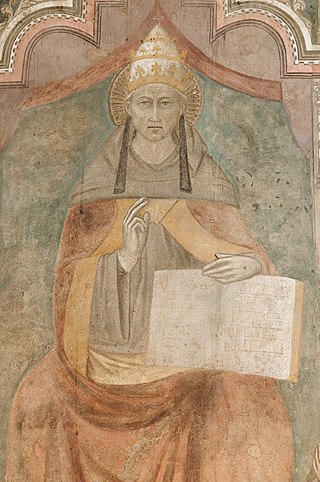
Pope Celestine V, born Pietro Angelerio, also known as Pietro da Morrone, Peter of Morrone, and Peter Celestine, was head of the Catholic Church and ruler of the Papal States for five months from 5 July to 13 December 1294, when he resigned. He was also a monk and hermit who founded the order of the Celestines as a branch of the Benedictine order.

Arezzo is a city and comune in Italy and the capital of the province of the same name located in Tuscany. Arezzo is about 80 kilometres southeast of Florence at an elevation of 296 metres (971 ft) above sea level. As of 2022, the population was about 97,000.

L'Aquila is a city and comune in central Italy. It is the capital city of both the Abruzzo region and of the Province of L'Aquila. As of 2023, it has a population of 69,558 inhabitants. Laid out within medieval walls on a hill in the wide valley of the Aterno river, it is surrounded by the Apennine Mountains, with the Gran Sasso d'Italia to the north-east.

The province of L'Aquila is the largest, most mountainous and least densely populated province of the Abruzzo region of Italy. It comprises about half the landmass of Abruzzo and occupies the western part of the region. It has borders with the provinces of Teramo to the north, Pescara and Chieti to the east, Isernia to the south and Frosinone, Rome and Rieti to the west. Its capital is the city of L'Aquila.

The Basilica of Saint Francis of Assisi is the mother church of the Roman Catholic Order of Friars Minor Conventual in Assisi, a town in the Umbria region in central Italy, where Saint Francis was born and died. It is a papal minor basilica and one of the most important places of Christian pilgrimage in Italy. With its accompanying friary, Sacro Convento, the basilica is a distinctive landmark to those approaching Assisi. It has been a UNESCO World Heritage Site since 2000.
Palena is a comune and town in the province of Chieti in the Abruzzo region of Italy.

The Basilica of Santa Maria Maggiore is a major church in the upper town of Bergamo, Northern Italy.

Padua Cathedral, or Basilica Cathedral of Saint Mary of the Assumption, is a Catholic church and minor basilica located on the east end of Piazza Duomo, adjacent to the bishop's palace in Padua, Veneto, Italy.

The Abbey of Santa Maria di Rovegnano is a Cistercian monastic complex in the comune of Milan, Lombardy, northern Italy. The borgo that has developed round the abbey was once an independent commune called Chiaravalle Milanese, now included in Milan and referred to as the Chiaravalle district.

The Abbey of Santa Lucia is an 11th-12th century, Romanesque and Gothic-style abbey in the comune of Rocca di Cambio, region of Abruzzo, central Italy.

The Basilica of San Fedele in Como is located in the city center. The present Romanesque church dates from 1120 and is dedicated to the Fidelis of Como.

The Abbey of the Holy Spirit at Morrone, known by various titles, is a former monastery some five kilometers outside of the town of Sulmona, at the base of Monte Morrone, in the Province of L'Aquila, region of Abruzzo, Italy.
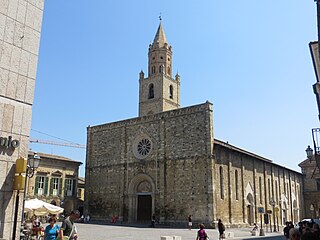
Atri Cathedral is a Romanesque Roman Catholic cathedral dedicated to the Assumption of the Virgin Mary in the town of Atri, Province of Teramo, region of Abruzzo, Italy.
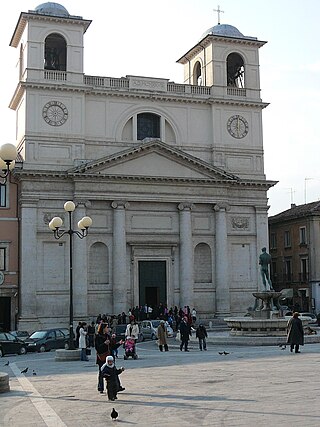
L'Aquila Cathedral is a Roman Catholic cathedral in L'Aquila, Abruzzo, Italy, dedicated to Saint Maximus of Aveia and Saint George. It is the episcopal seat of the Archdiocese of L'Aquila.

The Basilica of San Bernardino is a religious building located in L'Aquila, Italy. The church was built, with the adjacent cloister, between 1454 and 1472 in honor of St Bernardino of Siena. The facade was built by Silvestro dall'Aquila and later passed to Cola dell'Amatrice, reaching completion in 1542. It is a notable example of 16th century architecture combining Greek, Latin and Christian influences, divided into three orders, consisting of Doric, Ionic and Corinthian styles. The corpse of the saint is guarded inside the church in a mausoleum built by Silvestro dell'Aquila.
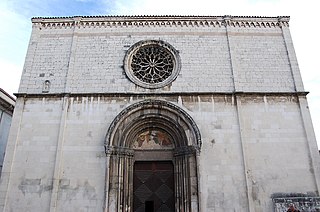
Chiesa di Santa Giusta is a Romanesque church in L'Aquila (Abruzzo).

Eremo di Sant'Onofrio al Morrone is an hermitage located in Sulmona, Province of L'Aquila ., dating back to the thirteenth century. A monk by the name of Pietro Angelerio living at this hermitage later became Pope Celestine V. The hermitage is located at an altitude of 620 meters, and can only be reached via a steep path from the village of Badia, on the eastern edge of the Valle Peligna.

Museo d'Arte Sacra della Marsica is a museum of religious art in Celano, Province of L'Aquila (Abruzzo).
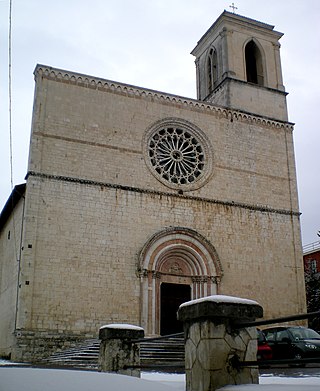
San Silvestro is a Gothic-style, Roman Catholic, former church in the town of L'Aquila, in the region of Abruzzo, Italy. The church is presently under restoration after the 2009 earthquake.
The following is a timeline of the history of the city of L'Aquila in the Abruzzo, a region of Italy.





















